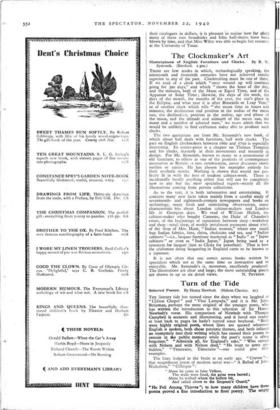The Clockmaker's Art
Masterpieces of English Furniture and Clocks. By R. W. Symonds. (Batsford. 2 gns.)
THERE are few trades in which, technologically speaking, the nineteenth and twentieth centuries have not achieved results superior to any of the past. Clockmaking must be one of them. If we read of a dock which "once wound up will continue going for 390 days,". and which, "shows the hour of the day, and the minutes, both of the Mean or Equal Time, and of the Apparent or Solar Time ; likewise, the days of the week, the days of the month, the months of the year, the sun's place in the Ecliptic, and what year it is after Bissextile or Leap Year," or of another clock which tells ‘" the mean time in hours and minutes, the declination and position in the zodiac of the mean sun, the declinaticri, position in the zodiac, age and phase of the moon, and the altitude and azimuth of the mean -sun the moon and a number of selected stars," we must admit that we would be unlikely to find craftsmen today able to produce such clocks.
The two quotations are from Mr. Symonds's new book, of which about half deals with furniture, half with clocks. The part on English clockmakers between 1660 and 1750 is especially interesting. Its centre-piece is a chapter on Thomas Tompion and his clocks, masterly in their movements and masterly in design. For Mr. Symonds, known to many as a connoisseur of old furniture, to others as one of the pioneers of contemporary decoration in Britain--a rare combination, never discusses exotic rarities or curios. He has chosen his examples entirely for their aesthetic merits. Nothing is shown that would not per- fectly fit in with the best of modern cabinet-work. There is incidentally hardly anything either that will not be completely new to any but the most specialised expert—nearly all the illustrations coming from private collections.
As to the text, it is both informative and entertaining. It contains many new facts taken mainly from a careful study of seventeenth- and eighteenth-century newspapers and books on technology, many fresh and stimulating observations, many characteristic bits about London cabinet-makers and London life in Georgian days. We read of William Hallett, the cabinet-maker who bought Cannons, the Duke of Chandos's estate, of the beginnings of separation between shop = workshop and shop=retail shop, of weekly instalment payments about 1707, of the shop of Mrs. Hunt, "Indian woman," where one could buy Indian fabrics, fans, china, cholocate and tea, and "Indian cabinets "—i.e., lacquer furniture marketed as " India " or "Japan cabinets" or even as "India Japan," Japan being used as a synonym for lacquer (just as China for porcelain). That is how the craftsman doing lacquering in England came to be known as a japarmer.
It is not often that one comes across books written by specialists which are at the same time so instructive and so enjoyable. Mr. Symonds's is, moreover, excellently produced. The illustrations are clear and large; the most outstanding pieces
are shown in up to six detail views. N. PEVSNER.


























































 Previous page
Previous page